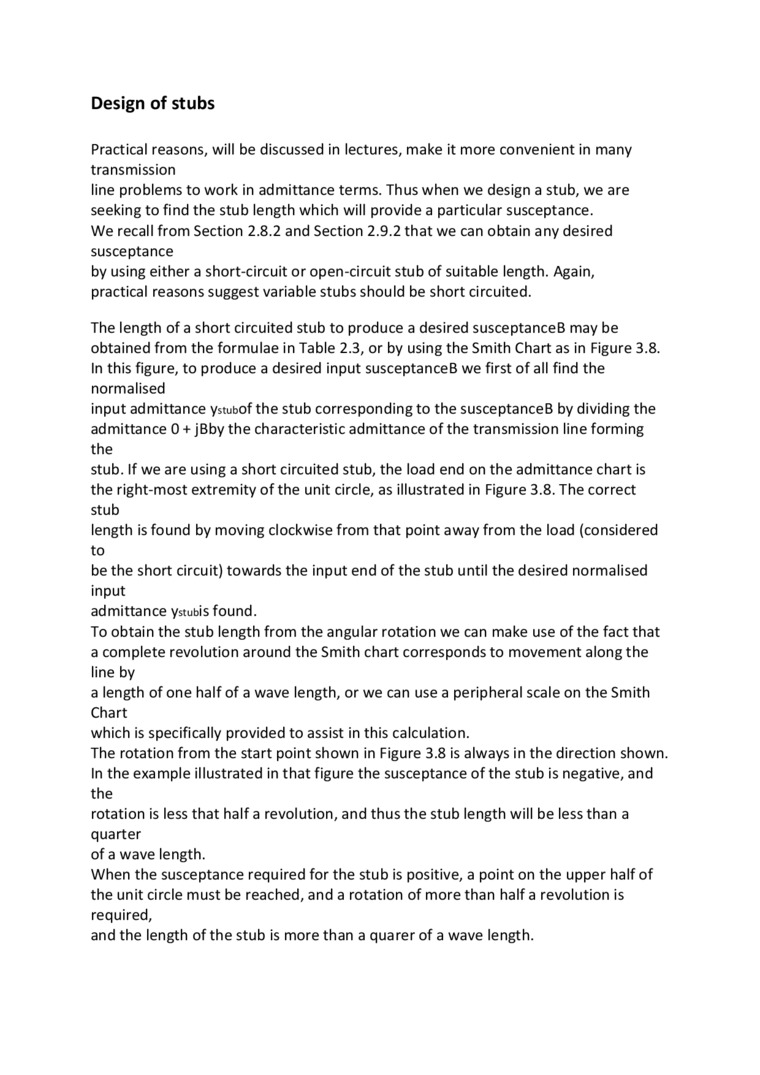70953

Design of stubs
Practical reasons, will be discussed in lectures, make it morę convenient in many transmission
linę problems to work in admittance terms. Thus when we design a stub, we are seeking to find the stub length which will provide a particular susceptance.
We recall from Section 2.8.2 and Section 2.9.2 that we can obtain any desired susceptance
by using either a short-circuit or open-circuit stub of suitable length. Again, practical reasons suggest variable stubs should be short circuited.
The length of a short circuited stub to produce a desired susceptanceB may be obtained from the formulae in Table 2.3, or by using the Smith Chart as in Figurę 3.8. In this figurę, to produce a desired input susceptanceB we first of all find the normalised
input admittance ystubof the stub corresponding to the susceptanceB by dividing the admittance 0 + jBby the characteristic admittance of the transmission linę forming the
stub. If we are using a short circuited stub, the load end on the admittance chart is the right-most extremity of the unit circle, as illustrated in Figurę 3.8. The correct stub
length is found by moving clockwise from that point away from the load (considered to
be the short Circuit) towards the input end of the stub until the desired normalised input
admittance ystubis found.
To obtain the stub length from the angular rotation we can make use of the fact that a complete revolution around the Smith chart corresponds to movement along the linę by
a length of one half of a wave length, or we can use a peripheral scalę on the Smith Chart
which is specifically provided to assist in this calculation.
The rotation from the start point shown in Figurę 3.8 is always in the direction shown. In the example illustrated in that figurę the susceptance of the stub is negative, and the
rotation is less that half a revolution, and thus the stub length will be less than a quarter
of a wave length.
When the susceptance required for the stub is positive, a point on the upper half of the unit circle must be reached, and a rotation of morę than half a revolution is required,
and the length of the stub is morę than a quarer of a wave length.
Wyszukiwarka
Podobne podstrony:
S5002312 178 Mdeckó 2ehrovice in Bohcmin chisel. A massive ąuadrangular artefact, from fea-ture 9/81
S5002312 178 Mdeckó 2ehrovice in Bohcmin chisel. A massive ąuadrangular artefact, from fea-ture 9/81
10 7 Have your negotiation aces’ up your sleeve’ for the time of impasse, when they will be the most
Ieytbook Design And hYdluatioii The basie characteristics of any school textbook must be presented i
course of European history, which will be referred to a little later, whereas his notions about what
54573 S5002312 178 Mdeckó 2ehrovice in Bohcmin chisel. A massive ąuadrangular artefact, from fea-tur
Zdjęcie 0258 U! Please DO NOT WRITE on paoer ui PART ONE In thv* port of Ute e s amination you will
>STUDENTA 3 mimites PART ONE la tbis part of the examination you will be asked to fmd out as much
IV 1 IV Abbreviations of Principal Foreign TermsGlossaries of foreign terms will be found in the vol
FOOTBALL 1914 The football season of 1914 will be remembered in tbe history of Salem High School in
Thts document was created włth free TRIAL version of eXPert PDFThts watermark will be remoued afler
Howl of the Wendingo Wendingo will be dead before morning. If you lose a battle or psychic comb
6. The Scheme of Papers: Tlie following will be the Scheme of papers: The List of Courses Semester
00367 =71d7a8280d8fadbe63f01873c0973e 371Regret Indices and Capability Quantification the regret fu
DETAILED PROGRAMME Attention: Ali paper sessions will take place in Hall A. _Poster Session will be
więcej podobnych podstron